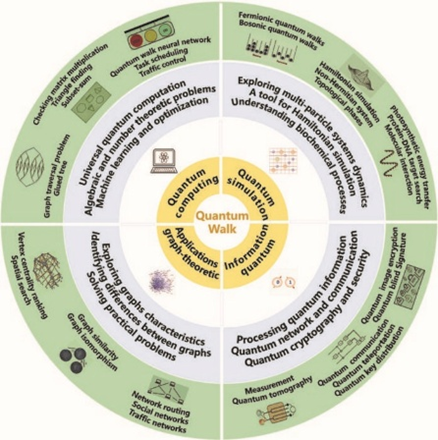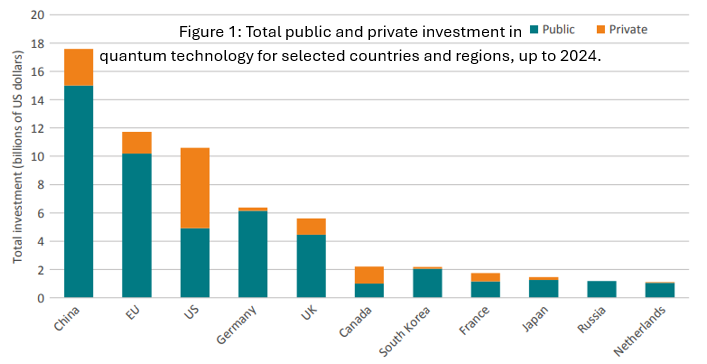From lab to market – time for Europe’s quantum leap
Introduction
The European Commission’s Quantum Strategy, released in July 2025, delineates a comprehensive plan to establish Europe as a global quantum technology leader by 2030. It aims to resolve Europe’s quantum innovation paradox. In fact, despite strong research and a growing start-up ecosystem, the region trails the US and China in patents, commercialisation, and private investment.
To address this, over €11 billion in public funding has been mobilised across EU institutions and member states over the past five years.
Forthcoming initiatives, including a proposed 2026 “Quantum Act”, are designed to attract private capital and enhance coordination. Quantum technologies are expected to revolutionise industries and offer benefits worth trillions within a decade.
Consequently, the strategy is pivotal for Europe’s competitiveness and technological autonomy, aiming to empower European firms and innovators while mitigating reliance on foreign actors. The ensuing analysis explores the strategy’s content and its broader economic and geopolitical ramifications for Europe.
Key objectives and initiatives
Adopted on 2 July 2025, the Quantum Europe Strategy presents a unified framework to strengthen Europe’s quantum ecosystem. Specifically, it confronts the challenge that, despite notable progress in quantum technology, Europe remains fragmented and underutilises its innovations.
In essence, quantum technology uses the unusual rules of quantum physics, where particles can be in several states at the same time or be instantly connected across distances, in order to unlock breakthroughs in computing and secure communication.
This lets quantum computers explore countless options at once, greatly speeding up tasks like complex simulations or data analysis. To this end, the strategy aims to establish Europe as a “quantum powerhouse” by 2030, converting scientific excellence into industrial and market leadership.

Source: EurekAlert
It is structured around the following four interconnected focus areas:
Research and innovation: coordinating agendas and strategically funding excellence to sustain Europe’s leadership in quantum science and facilitate its translation into industry. In particular, a new EU initiative will align R&D agendas and launch large-scale “quantum grand challenges” uniting academia and industry.
Quantum infrastructures: developing state-of-the-art hubs for designing and producing quantum technologies. To realise this ambition, the EU will support chip fabrication via six pilot lines and establish a quantum design facility. A 2024 roadmap will guide industrial-scale hardware production.
Quantum ecosystem: supporting start-ups, fortifying supply chains, and scaling enterprises through investment tools and public–private partnerships. Moreover, the so-called EuroHPC mandate will expand to back quantum efforts, and a new EU Scaleup Fund will target strategic tech sectors.
Security and defence applications: Europe will integrate quantum encryption, sensing, and computing into its space and security programs. To this end, a roadmap with the European Space Agency will guide satellite-based quantum communication, while “spin-in” efforts from 2026 will adapt civilian quantum advances for defence.
Consequently, this highlights quantum as both an economic asset and a security necessity, especially as quantum computers threaten current encryption, thereby prompting the EU’s push for quantum-secure networks through the EuroQCI initiative.
Importantly, the Quantum Act, anticipated in 2026, will guide funding mechanisms and provide a regulatory architecture. This legislative instrument, in turn, contributes to Europe’s transition from scientific leadership to commercial viability, underpinning the overarching goal to “bring EU states together around a unified vision”.
The Funding Bottleneck
Europe’s main obstacle lies is its insufficient venture capital inflows. Public investment is strong, but private funding lags behind global peers. As of 2024, only around 5–12% of worldwide private investment in quantum companies has gone to Europe, whereas the US attracts roughly half. The new strategy explicitly seeks to tackle this by aiming to “crowd-in” private investment through blended funds and by positioning public bodies as anchor customers for European firms.
While Europe continues to face persistent challenges in mobilising private investment, its foundational strengths in scientific research and entrepreneurial activity remain unequivocal. As of 2024, the continent held a leading global position in quantum science, accounting for the highest number of peer-reviewed publications in the field and 42% of all newly established quantum start-ups.
Prominent companies such as IQM (Finland), Pasqal (France), and Alice&Bob (Germany) exemplify this momentum. Collectively, these developments reflect a robust and increasingly sophisticated innovation ecosystem, anchored by world-class academic institutions and a maturing pipeline of early-stage ventures.
However, in the absence of adequate scale-up mechanisms, many of these firms face heightened risks of foreign acquisition or strategic relocation, signifying a trend that underscores the critical imperative to bridge the commercialisation gap in order to safeguard talent, intellectual property, and long-term strategic autonomy within Europe.
Nevertheless, a significant shortfall persists: US technology conglomerates such as IBM (NYSE:), Google (NASDAQ:), and Microsoft (NASDAQ:) channel hundreds of millions into quantum R&D, while Europe lacks equivalent corporate commitment.

Cohesion Through Quantum
Another persistent challenge has been institutional fragmentation across Europe, with individual countries running discrete quantum programs, frequently leading to redundancy and inefficiencies. Smaller member states struggle to fund major projects, while larger ones prioritise national interests over continental coordination.
The new strategy aims to address this by aligning national roadmaps and aggregating resources through shared platforms, hence cultivating a more cohesive and scalable quantum ecosystem.
Notably, Europe’s low quantum patent and IP output constitutes a considerable deficiency and presents a major headwind to converting research into innovation. The US, China, and Japan lead in filings, while Europe has only two entities in the global top 20, indicating strong research but limited commercialisation. The strategy addresses this by enhancing IP protection and knowledge retention.
Additionally, Europe faces a talent shortage in quantum engineering and software. To counter global competition, the Quantum Skills Academy and mobility programs aim to develop specialists and reduce brain drain.

Source: ecipe.org
In sum, Europe’s quantum landscape reflects notable scientific excellence and emerging startup activity, yet faces persistent challenges in scaling ventures, fostering integration, and matching the pace and scale of investment seen in the US and China.
The Quantum Strategy explicitly acknowledges these shortcomings and seeks to address them through coordinated funding, enhanced support for startups, and skills development, while capitalising on Europe’s scientific strengths and endured public commitment.
Geopolitical and Economic Implications
The EU’s quantum strategy carries significant geopolitical and economic implications, fundamentally concerning technological sovereignty. European leaders recognise that emerging technologies like quantum computing will be critical to future economic strength and national security, much like semiconductors or AI.
Therefore, by investing in quantum capabilities, Europe seeks to avoid dependency on foreign powers such as US cloud providers or Chinese state-backed firms for essential computing and encryption infrastructure. This autonomy is vital after past digital industry delays, thus enabling European banks and governments to rely on domestically built quantum technologies.
Success would allow Europe to set technology standards aligned with its values, whereas failure risks dependence on non-European providers. In essence, the strategy forms part of a broader push for strategic autonomy, alongside initiatives like the EU Chip Act and AI policies.
Geopolitically, the quantum race is framed as a tripartite competition between the US, China, and Europe, each with distinct models. The US leverages a dynamic private sector, whereas China relies on extensive state funding, and Europe pursues a hybrid approach with coordinated public funding and policy.
The strategy signals Europe’s intent to be a serious player, fostering both cooperation with allies such as Japan and Canada, while competition is marked by export controls and investment rivalries. China’s massive investment in quantum technologies underscores the urgency for Europe to bolster Western capabilities, as well as carve its own leadership niche. A multipolar quantum landscape could stimulate innovation but requires coordination on standards and security.
Economically, quantum technology promises transformative impacts across pharmaceuticals, industry optimisation, and climate modelling. Forecasts predict a global quantum market exceeding $170 billion by 2040, with potential value creation of $1–2 trillion by the mid-2030s. Therefore, developing a strong quantum sector could drive high-tech growth, create skilled jobs, and enhance competitiveness for Europe in key industries like automotive and aerospace. Ensuring domestic access to advanced quantum tools is ergo crucial to prevent European firms from falling behind global rivals.
The strategy also aims to strengthen Europe’s innovation ecosystem by fostering startups and scale-ups, addressing the “European paradox” of innovation. Success in quantum could demonstrate Europe’s ability to nurture global-leading tech firms, setting a precedent for emerging technologies. However, execution is critical; experts emphasise urgency, scale-up focus, and ecosystem integration as essential for future spearhead and broader innovation gains.
Finally, Europe’s quantum ambitions may influence global dynamics, encouraging increased US–EU collaboration to maintain allied leadership or provoking competitive responses. Europe’s coordinated approach could serve as a model for smaller countries, promoting a more balanced global quantum innovation network beyond Silicon Valley or Beijing.
Conclusion
In conclusion, the EU’s Quantum Strategy represents a bold effort to secure Europe’s future in a technology that is poised to reshape the global economic and security landscape. For European clients, executives, and policymakers, this policy is a clear signal that quantum technology is becoming central to industrial strategy, much like green energy or AI, and that Europe intends to be a leader, not a follower.
The strategy’s success will be measured in the coming years by whether Europe can nurture quantum champions and retain its talent and IP. If it can, Europe stands to enhance its competitiveness in key industries—finance, pharmaceuticals, logistics, defence—while upholding its technological sovereignty in a critical domain.
If it falters, the risk is falling behind and finding European industry reliant on foreign quantum infrastructure by the 2030s, which would have economic and strategic downsides. The next decade will thus be pivotal. With strong public backing and an emerging united approach, Europe has set the stage for a quantum leap, now it must execute on this vision to secure its industrial and strategic future.

